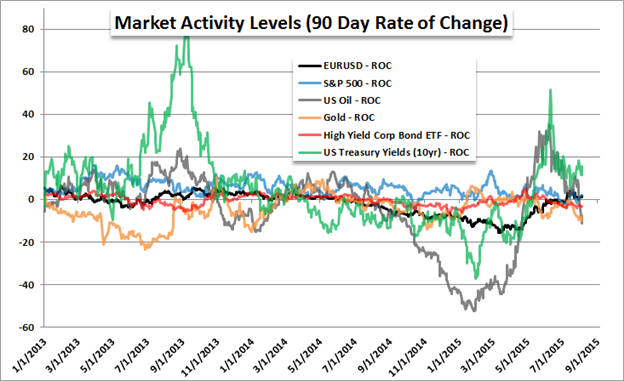Talking Points- Volatility, like leverage, is a double-edged sword for investors
- FX volatility more consistent than stocks, implied readings show
- Realized volatility lower in FX vs. Treasury bonds, commodities
Volatility is a frequently misunderstood concept even by seasoned financial market professionals. While investors are reasonably wary of rapidly moving assets because of the increased level of risk they represent, they frequently overlook volatility’s benefits for generating trading opportunities. To the uninitiated, trading currencies seems to intuitively trigger fears of erratic price swings. A deeper look at how volatility levels compare across various asset classes reveals FX to be a sensible component for both long- and short-term portfolios.
Benchmarking to June of 2014—an extraordinary activity lull since 2007—it can be seen that volatility levels across different asset classes have shown some extraordinary differences. The broader financial system started to churn broadly towards the end of 2014. However, not all assets would maintain this heightened level of action. For example, currency market volatility has held its buoyancy better than most.This has stemmed from the impact of divergent monetary policies as well as discrete events like the renewed Greece crisis.
By contrast, far more dramatic volatility spikes in the equity market have also faded more readily. Volatility in stocks—as represented by the VIX index—experienced a more exceptional increase in October and December, but has trended towards lower levels for most of 2015. If we look at an overlay of different volatility indices together we can see where activity levels started to diverge meaningfully across the financial assets. Comparing volatility levels for currencies against those of more ”traditional” markets, active traders can start to see different opportunities arise.

While volatility is appealing to the speculator, it should also be considered a measure of risk to positions. That said, the indicators shown above do not show the full picture. Volatility indexes like the S&P 500-based VIX reflect ”implied volatility”, which represents expected annualized price action. When we look at actual (typically called ”realized”) market movement, the picture looks different.
Using a 90-day rate of change (ROC) to standardize movements across the different market types, we see the standings on what is volatile shift. Movements in commodity prices and government bond yields have proven exceptionally dramatic. Comparatively, equity levels are more restrained and EUR/USD—as a benchmark for FX—is similarly reserved. Additional risk comes into the picture when we employ leverage on any of these assets, as is the standard amongst FX retail traders. However, the trader can control that gearing as well as position size more finely than in many other asset classes.

Overall, volatility is an important tool for all market participants as both a measure of return and risk. For the tactical and shorter-term “trader”, volatility is pursued more as a source of opportunity. In contrast, the passive and longer-term ”investor” looks to minimize volatility relative to projected returns (income) as much as possible. From both perspectives, FX is an asset class that deserves an important place in portfolios.
